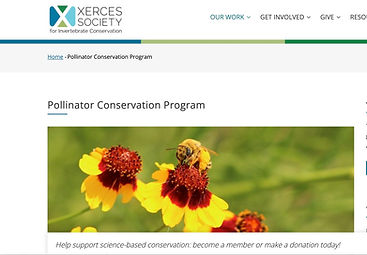Research & Citizen Science Along the Pollinator Pathway

Become a community scientist!
Here are some ways to report your findings as more pollinators visit your yard!
Join the Pollinator Pathway iNaturalist project and add your observations to the over 400,000 others seen along the Pathway. Contact us (info@pollinator-pathway.org) to get help setting up a project for your town or neighborhood.
Join this regional project run by Dr. Robert Gegear of UMass-Dartmouth to support pollinator species at risk specifically by tracking pollinator-plant interactions at sites across the Northeast. Anyone can submit observations by taking videos using a smartphone or tablet, and all data uploaded is verified by Dr. Gegear's lab. To participate in the project, download the Beecology web app to your smartphone or tablet and follow the instructions. The app currently supports bumblebee observations, with butterfly observations to be added later this year.
Research Happening Along the Pathway
Send us information (info@pollinator-pathway.org) to add to this page about pollinator research projects you are working on.
Measuring Species Return After Planting for Pollinators
Landscape Interactions located in Western Massachusetts works with Pollinator Pathway organizers (individuals, communities, and municipalities) to design restoration plantings and pollinator action plans with a focus on planting for specialist bees and . Landscape Interactions measures the success of its planting projects by documenting changes in pollinator species populations on sites before and after plants are installed. Counts are done by a Landscape Interactions entomologist and trained assistants.
Learn more at this recorded webinar about the McKeon Farm project in Ridgefield, CT.
Download and use or share the planting toolkits from these projects commissioned from Landscape Interactions along the Pollinator Pathway:
Town Pathway Citizen Science Research Projects
The Xerces Society has awarded grants to Pollinator Pathway organizers to remove invasives and add native plants to restoration sites, and follow the plantings with pollinator counts. One such project is along the Norwalk River Valley Trail in Wilton, CT.
Here is the Xerces Society Bee Monitoring Protocol
Here are some sample monitoring sheets from the Wilton project


The Wilton Pollinator Pathway, led by resident Joe Bear, is replacing .75 acres of invasive mugwort with a vast pollinator meadow at Allen’s Meadows, a park that houses playing fields, community gardens, walking trails, and is an Audubon birding hotspot. Joe receives support from the Norwalk River Watershed Association and has partnered on grants from the Connecticut Ornithological Association, Hartford Audubon Society, and Sustainable CT. Joe is using tarps, and avoiding all pesticides, on sections of mugwort for 7 months, 11 months, and 18 months, testing the optimal length of time for eradicating roots systems of mugwort. Results of this work will be reported here.
The Norwalk Pollinator Pathway & the Norwalk River Watershed Association is experimenting with tarping areas of Japanese knotweed and of Australian phragmites in Norwalk to determine the length of time necessary for killing the roots of these stubborn invasives. Results will be reported here.
Send us your projects to report on here!

